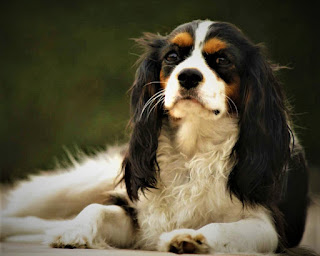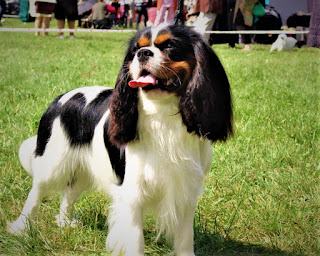Cavalier King Charles Spaniel
History
The ancestor of the Cavalier King Charles Spaniel is the toy
spaniel, which was very popular in England and Europe in the 16th – 18th
centuries. In more recent times, namely in the 19th and 20th centuries, these
dogs practically disappeared, and therefore it was incredibly difficult to
restore the breed. The Cavalier King Charles Spaniel breed received its name
from the name of the monarchs Charles I and II, the grandchildren of Queen
Mary.
Like the Queen, both monarchs were extremely fond of
spaniels, and Charles II (in English this name is spelled and pronounced as
Charles) issued a special decree that stated that the spaniel could be brought
to any public place and even the parliament building. He himself has never
appeared anywhere without at least two or even three of his favorites.
When King Charles II died, the popularity of these dogs
began to fade, because in these times small breeds of dogs were generally quite
popular, which means that spaniels had high competition. In their place began
to come pugs, which, like an oriental curiosity, excited the minds of the
European aristocracy. Moreover, pugs even interbred with spaniels, which is why
the latter subsequently acquired a shorter, flattened muzzle and a slightly
modified skull.
Despite the fact that many noble persons after the death of
the king ceased to consider representatives of this breed their favorites,
there were no changes in the estate of the Duke of Marlborough. For quite a
long time, a cavalier King Charles Spaniel was kept and bred in this place.
At the beginning of the 20th century, namely in 1920 - 1925,
these dogs were practically gone. They were so few that when an enthusiast
named Eldridge wanted to recreate the breed, he simply could not find a single
individual. He searched for pets at Crufts dog shows and private owners, and
then, enlisting the support of the English Kennel Club, offered 25 guineas
(pounds sterling) to the one who would provide him with a toy spaniel.
The amount is actually huge at the time. Guinea was divided
into shillings and shillings into pence, an ordinary worker could receive one
pound sterling per month. As a standard, the type of dog that was during the
reign of Charles II was chosen. Eldridge's dog was provided by a woman named
Mostyn Walker, and this happened in 1928.
In the same year, a dog show was to be held, however,
Eldridge did not live a month before this event. At the show, the woman was
handed money and took her dog named Ann, Son, as the standard for the breed
Cavalier King Charles Spaniel. Several dogs were transported to America in the
middle of the century, and there, after much difficulty, enthusiasts were also
able to register the Cavalier King Charles Spaniel breed at the American Kennel
Club.
 |
Cavalier King Charles Spaniel Puppy |
Characteristics of the breed
popularity 09/10
training 05/10
size 01/10
mind 05/10
protection 02/10
Relationships with children 08/10
Dexterity 04/10
Molting 07/10
Breed Information
|
Country |
England |
|
Lifetime |
9-15 years |
|
Height |
Males: 30-33 |
|
Weight |
Males: 6-8 |
|
Length of coat |
longhair |
|
Color |
black-tan, ruby, tricolor |
Price |
800 - 1900 $ |
Description
These are small dogs, with compact physiques. The muzzle is
slightly flattened, short, and the forehead is pronounced. The limbs are
proportional to the body, the ears are long, and the tail is short. The coat is
long.
Personality
Cavalier King Charles Spaniel is a beautiful breed and decorative dog. No other functions are
provided in principle, and this has been cultivated and nurtured in the breed
for hundreds of years. In the Middle Ages, these dogs lived in luxury and
although now times have changed, they still love to be at home, in a cozy
atmosphere, together with the owner and loved ones.
Cavalier King Charles Spaniel likes to be held in his arms
and generally loves affection. To be in isolation from your family and owner,
this breed cannot categorically, and therefore accept the fact that if you buy
this dog, leave it for friends while you go on vacation, it will not work. The
animal will have to be taken with you.
In general, the breed Cavalier King Charles Spaniel has a
good, soft, docile character. But if you spoil him, the character can
deteriorate, the dog will become capricious and may not even respond quite
adequately, even to members of his own family. Although, usually these dogs
are very friendly and treat literally everyone well. Especially if this person
offers delicacies.
King Charles Spaniel has normal energy levels but can be
lazy. In any case, regular walks and active games are necessary. They treat
children well, and rarely show aggression towards them, but, in any case, the child
must be trained in the correct behavior with the animal.
Teaching
By and large, the whole education of these dogs comes down
to forming the right character in them. For the sake of justice, it should be
noted that most individuals by nature have a harmonious and obedient
disposition, and therefore, usually, there are no problems with upbringing.
Unless you yourself spoiled your dog and spoiled its character.
Of course, you need to train your pet in basic commands, and
also, if you want to take part in various dog shows (be sure to the first study in
which disciplines this breed is used), you can form the training process,
starting from specific tasks.
How to take care of Cavalier King Charles Spaniel Dog?
The Cavalier King Charles Spaniel breed has a long coat that
needs regular combing and combing. This will have to be done at least 2, or
even 3-4 times a week. In addition, it is necessary to clean the eyes daily
from deposits, as well as monitor the cleanliness of the ears. Bathe the dog once twice a week, the claws are cut on average 3 times a month.
Because of the long coat, they are quite sensitive to heat,
so it is harmful and even dangerous for them to be in the sun for a long
time. After a walk, be sure to inspect the long ears of the dog for the
presence of insects, especially ticks, and pollution - often spaniels collect
dust, dirt, and plants in the park with their ears.
Common diseases
The breed of dogs Cavalier King Charles Spaniel has a
tendency to such diseases:
- mitral valve disease;
- syringomyelia - this disease affects the brain and spine and appears to be common in cavaliers;
- episodic fall - this condition is often confused with epilepsy, but the spaniel remains conscious during a fall or attack;
- hip dysplasia;
- knee dislocation;
- Keratoconjunctivitis Sikka - if left untreated, it can lead to blindness;
- nervous scratching.
Beautiful Pictures of Cavalier King Charles Spaniel








.jpg)
.jpg)
.jpg)
0 Comments